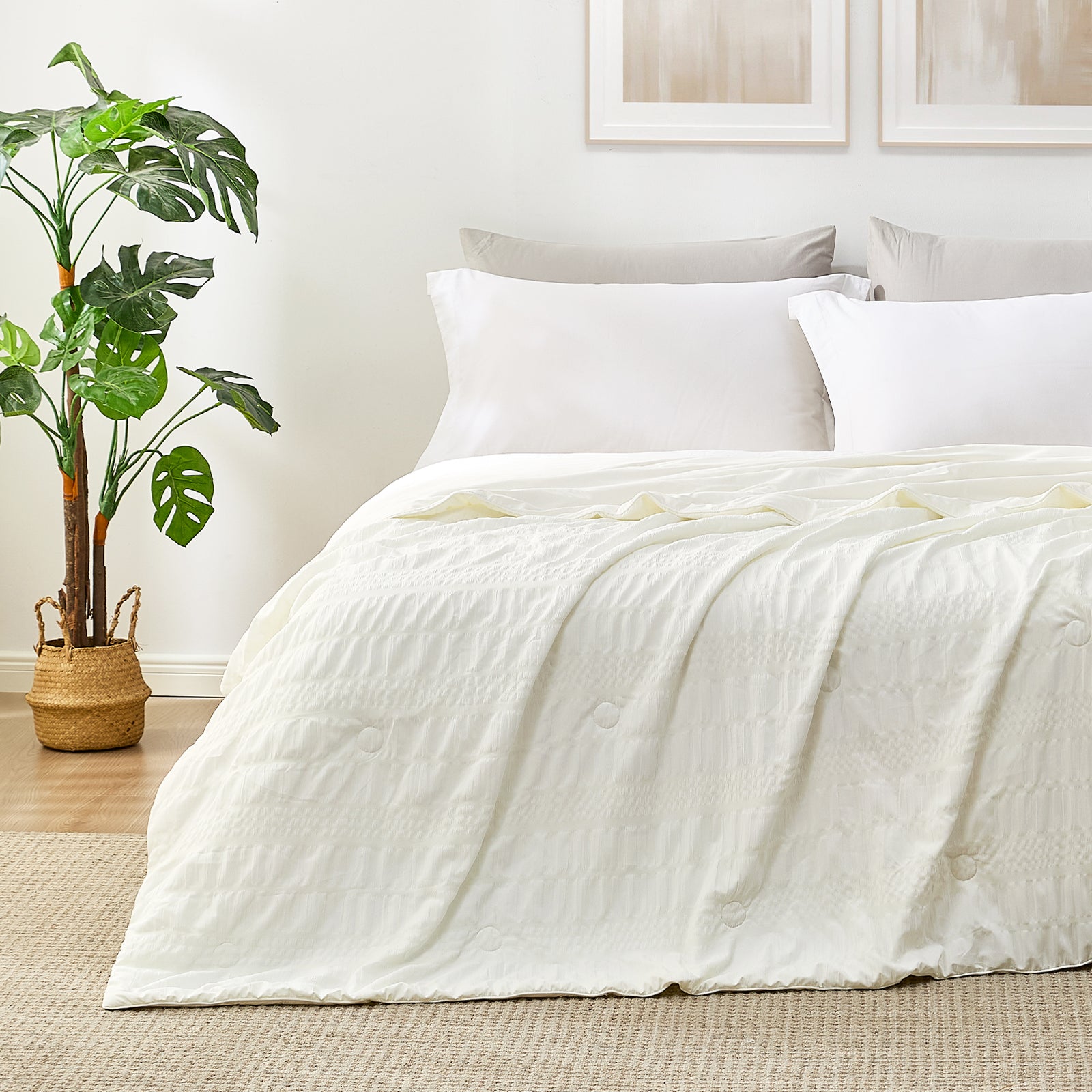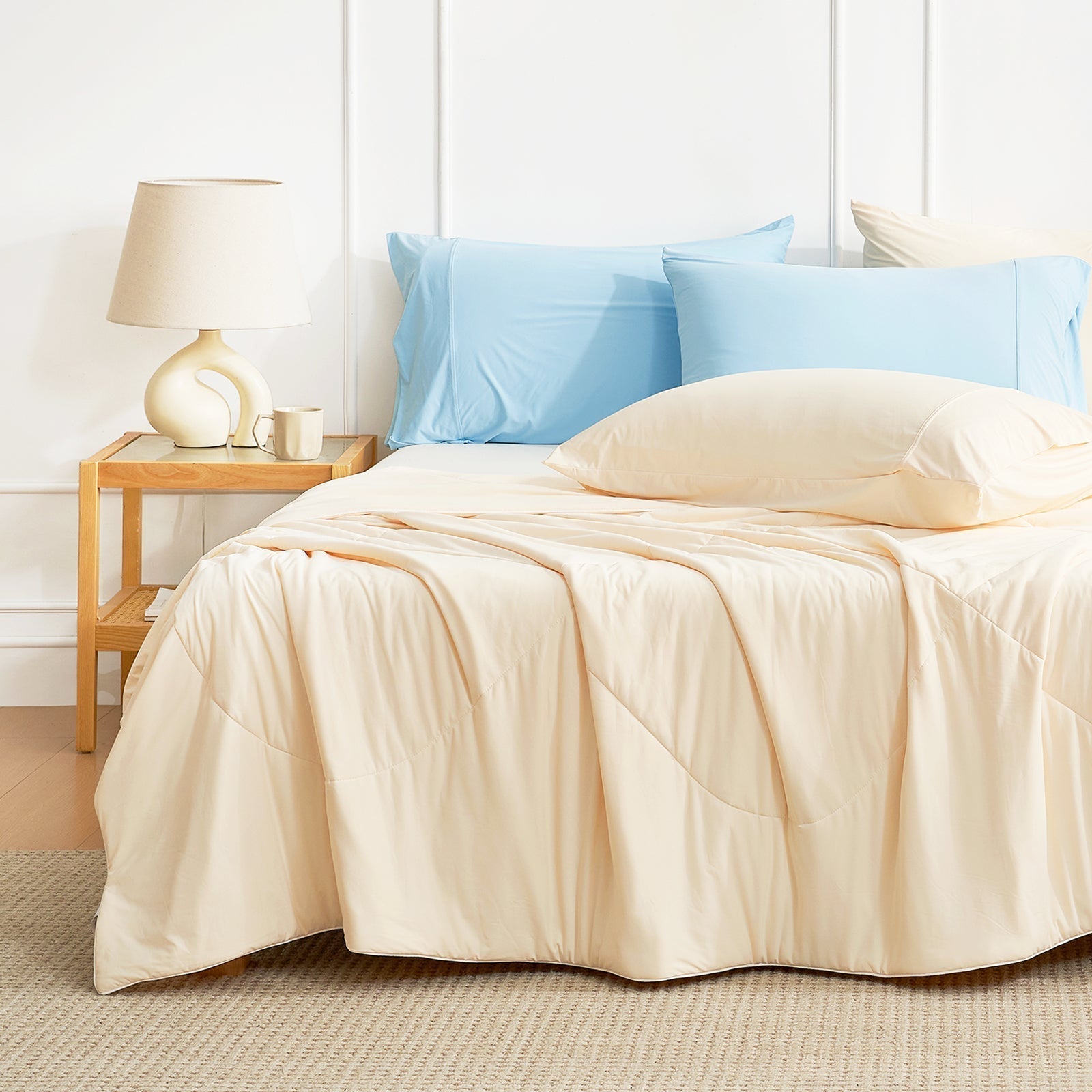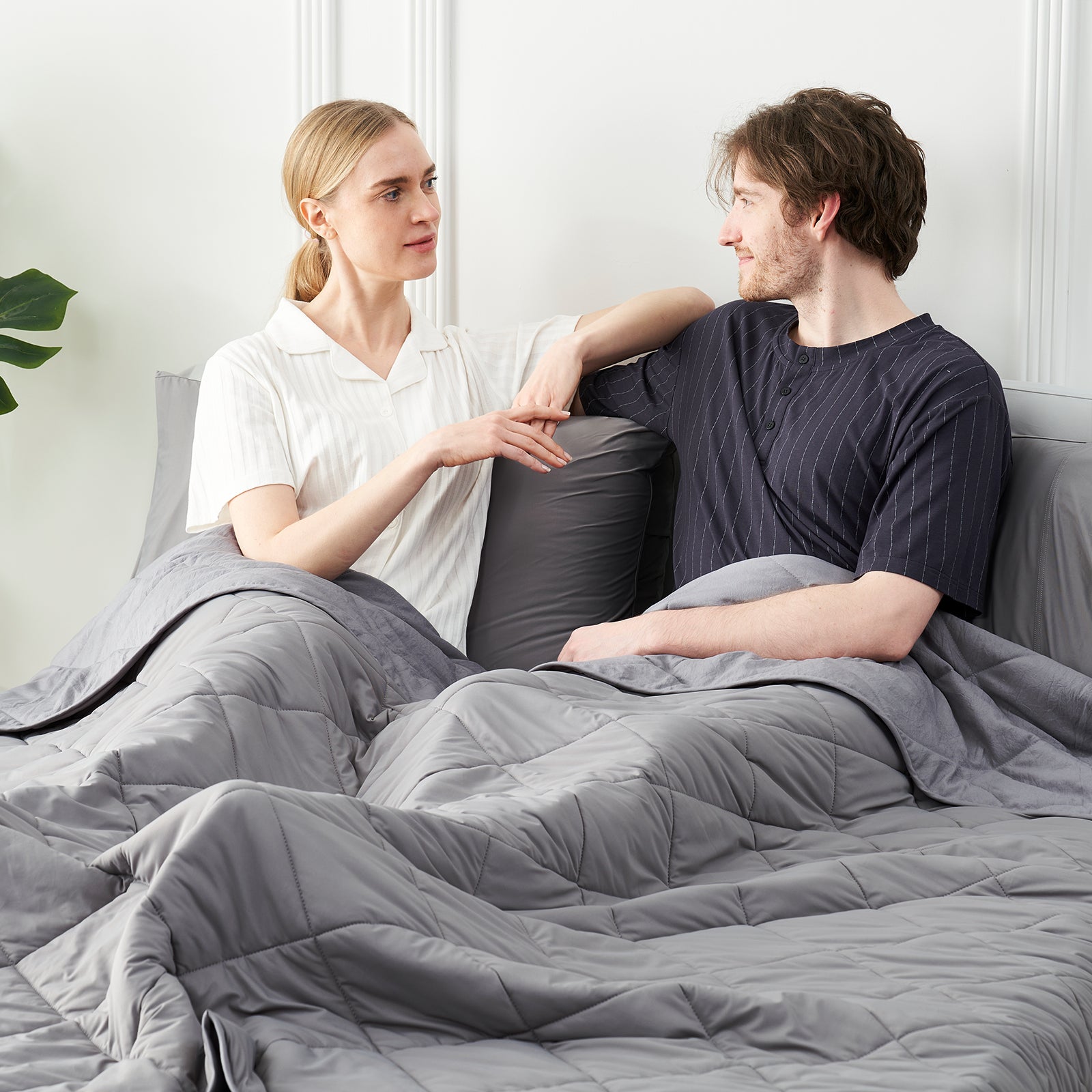Did you sleep well last night? If you didn't enjoy your sleep because of the culprit bedding, you should change your bedding as seasons change. The blanket that kept you cozy in winter can leave you sweating in summer, while lightweight summer options won't cut it when temperatures drop. Your body needs different support through changing seasons, and the right blanket is key to good sleep all year round. With some simple swaps, you can transform restless nights into refreshing sleep during every season.
Why Your Blanket Needs to Change with the Seasons
Summer Overheating Causes Insomnia and Night Sweats
During hot weather, heavy bed blankets trap your body heat against you, causing sweating and waking you up during the night. Your body controls the heat and cools down enough to create sleep hormones to induce deep sleep stages in you, but heat trapping prevents your body from controlling itself in that situation. Replacing cool, light airy blankets during summers keeps body heat within optimal levels to allow for fast sleeping and sleep continuity.
Winter Chill Disrupts Deep Sleep Phases
Cold bedroom temperatures in winter force your body to work harder to warm up, pushing you away from deeper stages of sleep. You contract your muscles and acquire restless and light sleep when cold. Quality winter blankets serve as insulators that keep your body heat in, thus relaxing your muscles completely and allowing you to have unbroken deep sleep cycles.
Different Seasons Require Different Material Properties
Summer blankets must be moisture-wicking and breathable to address heat and humidity, whereas winter blankets must retain warmth without being heavy or restrictive. The same features that make a blanket suitable for January make it unbearable during July. Seasonal blankets ensure you have the right weight, breathability, and insulation at any time, depending on weather conditions.
Seasonal Allergens Demand Specific Blanket Materials
Spring pollen, summer dust mites, and fall mold spores all affect the quality of sleep for allergy sufferers. Seasonal rotation of the blanket allows you to choose fabrics that repel the most prevalent allergens for each season. Hypoallergenic products for high-allergy seasons and easier-to-clean fabrics during peak pollen seasons can significantly reduce night symptoms and improve the quality of sleep.
Spring: Choose Lightweight, Breathable Bed Blankets for Fluctuating Temperatures
Spring combines mild days with cool nights and unpredictable temperature swings. Your blanket should be light enough for warmer evenings but adaptable for chilly nights.
Best Materials for Spring Nights
- Cotton: Medium-weight cotton blankets provide balanced breathability and warmth. They wash easily—helpful during spring allergy season.
- Bamboo: These silky, lightweight blankets wick away moisture on warmer nights and naturally resist common spring allergens.
- Lightweight microfiber: Affordable and soft, these blankets offer just enough warmth for cool evenings while allowing heat to escape when temperatures rise.
- Q-Max > 0.4 cooling fabric: This innovative material from Cozy Bliss absorbs body heat while accelerating moisture evaporation. It provides just enough warmth for cool spring nights while preventing overheating on warmer evenings.
Recommended Spring Blanket Types
- Light quilts or coverlets: These provide consistent, gentle warmth without the bulk of winter bedding.
- Open-weave cotton blankets: The loose weave allows excellent air circulation while still providing light insulation.
- Throw blankets: Keep one or two nearby to add an extra layer on cooler nights or remove when temperatures rise.
Pro Tip: Choose blankets that layer well with your sheets, allowing for quick adjustments as spring temperatures fluctuate throughout the night.
Summer: Select Ultra-Breathable, Moisture-Wicking Bed Blankets to Prevent Night Sweats
Summer demands lightweight blankets that prevent overheating while still providing the comfort of a light covering.
Summer-Friendly Materials
- Cotton: Choose percale or muslin weaves specifically for hot weather. These lightweight options feel crisp and cool against skin.
- Linen: The premium choice for hot weather, linen offers superior breathability and gets softer with each wash. Though more expensive, it excels at keeping you cool.
- Bamboo: Perfect for humid conditions, bamboo wicks away moisture and has natural cooling properties that help lower body temperature.
- Silk: Feels cool to the touch and regulates temperature well, though requires more careful washing than other options.
- Q-Max > 0.4 cooling fabric: This advanced Cozy Bliss material can reduce skin temperature by 2-5°C by efficiently drawing away heat and humidity. Ideal for hot sleepers who struggle with night sweats during summer months.
Recommended Summer Blanket Types
- Light cotton or linen throws: Provide minimal coverage without adding weight or trapping heat.
- Dohar blankets: These traditional Indian three-layer cotton blankets are specifically designed for hot weather, offering breathability with minimal insulation.
- Top sheet only: For extremely hot nights, a simple sheet may be enough, with a lightweight throw nearby for early morning hours.
Pro Tip: Look for products specifically labeled "cooling" or "breathable" — many use technical fabrics designed to maximize airflow.
Fall: Add Medium-Weight Bed Blankets with Thermal Properties for Cozy Night
Fall creates ideal sleeping conditions—cool enough to enjoy being cozy under blankets without extreme cold. Your blanket should provide moderate warmth while remaining breathable.
Fall-Perfect Materials
- Flannel cotton: This brushed cotton provides extra warmth without excessive weight. Its slightly fuzzy texture feels cozy as temperatures drop.
- Merino wool: Lighter than heavy winter wools, merino blankets offer excellent temperature regulation and naturally wick away moisture during rainy fall weather.
- Fleece: Delivers exceptional softness with good warmth. Modern fleece comes in various weights perfect for transitional fall temperatures and is typically affordable.
- Medium-weight microfiber: Provides reliable warmth without bulkiness. These blankets wash well—useful when keeping windows open on cool fall nights.
Fall Blanket Types
- Medium-weight quilts: Provide consistent warmth distributed evenly across your body.
- <a href="https://www.cozybliss.com/collections/blankets-fleece" title="blankets fleece">Fleece blankets: Balance comfort with practical warmth in various thickness options.
- Knit blankets: Add interesting texture while trapping warm air in their patterns, making them both decorative and functional.
Pro Tip: Choose blankets that can later serve as an additional layer under winter bedding. Look for non-bulky options with good insulation to work both alone now and as part of a layered approach in winter.
Winter: Layer Insulating Bed Blankets for Maximum Heat Retention Without Bulk
Winter requires serious insulation that traps body heat efficiently without feeling heavy or restrictive.
Winter Warmth Materials
- Heavy wool: Provides excellent insulation and wicks away moisture. Modern wool blankets are often treated to reduce scratchiness while maintaining their natural warming properties.
- Down: Offers the best warmth-to-weight ratio with a cloud-like feel. Quality down blankets trap body heat in thousands of tiny air pockets and last for decades with proper care.
- Down alternatives: Provide similar benefits without using animal products. These synthetic fills offer comparable warmth without triggering allergies and are easier to clean.
- Sherpa fleece: Combines smooth fleece on one side with a sheep-wool-like texture on the other to maximize both comfort and heat retention.
- Heavy microfiber: With dense weave patterns, these affordable blankets trap heat effectively and often feature double-sided designs for added insulation.
Winter Blanket Types
- Heavy quilts/comforters: Look for high fill power (600+) for serious warmth on the coldest nights.
- Duvets with warm inserts: Allow you to change covers while maintaining maximum insulation.
- Weighted blankets: Provide both warmth and comforting pressure for deeper sleep.
- Layered blankets: Combine different blankets for customizable warmth throughout the night.
Pro Tip: For very cold bedrooms, consider heated mattress pads to pre-warm your bed. Modern versions are safer than older models and can be turned off once you're in bed.
Switch Bed Blankets as Seasons Change!
Switching your blankets as seasons change is a simple way to improve your sleep all year round. Each season requires different blanket materials and weights to help your body maintain the ideal temperature for good sleep. Summer calls for lightweight, breathable options, while winter demands insulating layers that trap warmth. Spring and fall need adaptable bedding for changing temperatures. By matching your blanket to the current season, you can turn restless nights into refreshing sleep no matter the weather outside.







Leave a comment
This site is protected by hCaptcha and the hCaptcha Privacy Policy and Terms of Service apply.